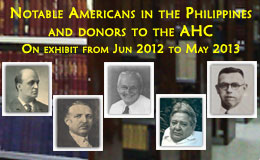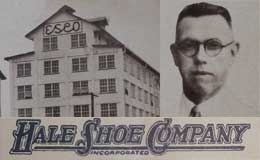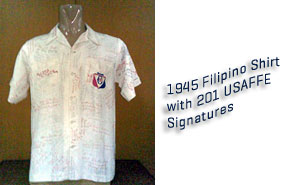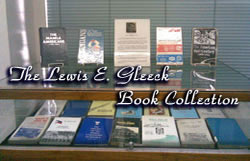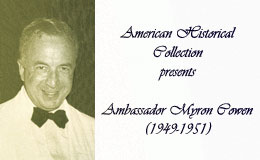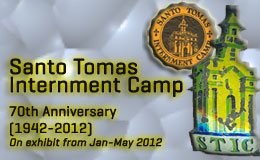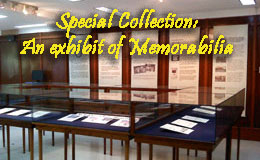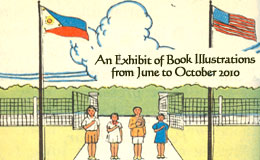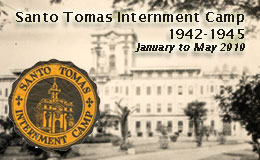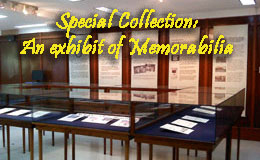
The American Historical Collection's (AHC) vast holdings of books, periodicals, documents, photographs, maps, and memorabilia items brings about the memory of America in the Philippines. To display this great collection thru exhibit is to showcase the important historical records and events of the Philippines during the American colonial period. The objective of the exhibits is to promote awareness and use of the collection, and to promote the shared history of Philippine-American relations. AHC maintains both permanent exhibits and temporary exhibits on special themes. |
The exhibit features Americans who individually made their mark in Philippine-American history. They contributed to shaping the nation as Governor-General (William Cameron Forbes); as a Manila lawyer, a mason, and a bibliophile (Eugene A. Perkins); as government treasurer (Leonard G. Dawson); as a guru in Manila (David T. Sternberg); and as a pioneer shoe manufacturer (Frank F. Hale). Their personal collection of books, memorabilias, and photographs donated to the American Historical Collection are on display from June 2012 to May 2013. (Click here to download brochure).
|
A historical display of the American Historical Collection's home from the U.S. embassy to the Thomas Jefferson in Makati, then the turn-over of collection to its present home at the Ateneo de Manila University in 1995. The exhibit also includes the photos of U.S. Ambassadors who visited the collections, namely Amb. Negroponte, Amb. Hubbard, and Amb. Ricciardone. |
FRANK H. HALE COLLECTION Frank Hale came to the Philippines in 1898 as a shoe maker for the American army. He later ventured in the shoe business in the Islands and founded the Hale Shoe Company, the maker of the famous ESCO shoes. The company is the largest operated by filipinos who worked with him for many years. In the 1930s the company employes 600 employees who produced 2,000 pairs of shoes per day. They were very proud of their slogan "Esco shoes is made by Filipinos for everybody." On display are pair of shoes, leather briefcase with inscription: F.H. Hale, photos, and other memorabilia items. (Click here to download brochure) |
This is the believe-it-or-not story about a white sharkskin shirt hand-embroidered with 201 names. The hand written signatures which also carry their home addresses were those of American soldiers camped out in Talisay, Negros Occidental during the liberation of the Philippines in 1944. This shirt probably the only memento of its kind in existence, bridging our world today to the time when American liberation forces ended the Japanese occupation of the Philippines. (Click here to download brochure) |
|
The exhibit showcase 19 books and scores of articles written by the late Mr. Lewis E. Gleeck, Jr. on the American experience in the Philippines. Mr. Gleeck was a member of the Foreign Service of the United States, serving several times in Washington and in Canada, Finland, Sweden, Austria, Iceland, Norway and Pakistan before arriving in the Philippines, where he retired after six years (1962-1969) as Consul General of the American Embassy in Manila. He then joined the USAID to work on land reform and cooperatives and subsequently to serve for several years as consultant on base-community relations to the U.S. Navy at Subic Bay. He was a long-time editor of the AHC Bulletin and curator of the AHC library. Please click here to download the list of books and reports written by Mr. Gleeck. |
|
America’s ambassador to the Philippines, the Hon. Myron Melvin Cowen, arrived in Manila on Saturday, May 21, 1949. (Click here to download brochure) |
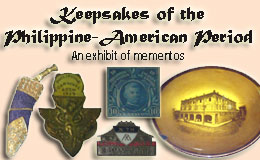
Experience history from mementos of the past and embrace tidings of antiquity! This exhibit will show you the vast wealth of items contained in the American Historical Collection. These include interesting and poignant materials such as pins, medals, commemorative coins, swords, stamps, envelopes, World War II letters, Santo Tomas Internment Camp arm band, and Japanese Mickey Mouse money. (Click here to download brochure) |
|
Seventy years ago, the University of Santo Tomas served as an internment camp for the protective custody of enemy aliens. On the 4th of January 1942, 300 residents from the
Malate district interned to form the first contingent. Come January 27, 1942, a population of 3,328 was recorded. |
|
On the occasion of Rizal's 150th birthday, the American Historical Collection proudly presents the Austin Craig Album. Craig is an American teacher who arrived in the Philippines in 1904. He was a historian and a Rizal Scholar who is an avid collector of Rizaliana materials. The album features intimate pictures of Rizal, his family, his friends, his sweetheart, his sculptures, and his poetry. Of historical interest in this album are pictures of Rizals' cell in Fort Santiago, former grave in Paco Cemetery, an 1872 receipt of payment to the Calamba land that they tilled, and Rizal's genealogy. (Click here to download brochure). |
|
The exhibit showcase the treasures of the American Historical Collection. These are the photographs, audiovisual materials, microfilms, and memorabilia. They greatly extend the scope of the collection and, because quite a number of them -- both the photos and other materials -- are personal, they also help humanize it. The memorabilia is oOn exhibit from January-May 2011. (Click here to download brochure). |
|
The exhibit showcase illustrations from books published during the American Era. The pictures from the different artists display creative interpretations depicting life, culture, and things during the time. This event presents works by Fernando C. Amorsolo, Carlos V. Francisco, and others. (Click here to download brochure). |
|
On 4 January 1942, the first truck-load of American internees was brought in to the oldest university. This brought to the organization of the Santo Tomas Internment Camp (STIC). The camp witnessed the life of the prisoners, how they lived, hoped, played, worked for each other, how they cope with their loss of freedom and their uncertainty in the future. |
AMERICAN HISTORICAL COLLECTION
3/F Rizal Library Special Collections Building, Ateneo de Manila University, Loyola Heights, Quezon City, Philippines
Tel: (632) 426-6001 loc 5567 • Fax: (632) 426-5961 • Email: ahc@admu.edu.ph • Web: rizal.lib.admu.edu.ph/ahc
8:00 AM to 5:00 PM (Monday to Friday); 8:00 AM to 12:00 NN (Saturday)
